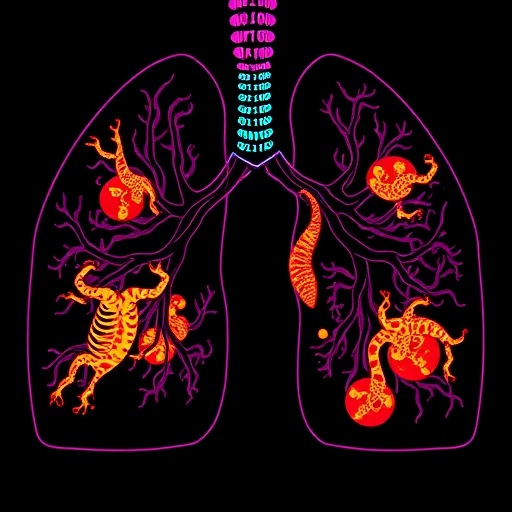In a groundbreaking study published in Nature Communications, researchers have unveiled an integrated molecular and clinical portrait of pulmonary large cell neuroendocrine carcinoma (LCNEC), a notoriously aggressive and poorly understood form of lung cancer. This work sets a new standard for unraveling the complex biology underlying LCNEC, paving the way for more precise diagnoses and tailored therapeutic strategies against a malignancy that has long challenged oncologists worldwide. By combining cutting-edge genomic profiling, transcriptomic analyses, and clinical data, the consortium of scientists led by Nassar, Kim, and Adeyelu offers unprecedented insights into the heterogeneity and molecular architecture of this lethal tumor subtype.
Pulmonary large cell neuroendocrine carcinoma represents one of the more enigmatic entities within lung cancer taxonomy, interspersed between non-small cell lung carcinoma and small cell lung carcinoma in terms of both histopathology and clinical behavior. Despite clinical similarity to the latter, LCNEC exhibits distinct genetic and phenotypic characteristics that have confounded attempts at uniform classification and therapeutic targeting. This study addresses these challenges head-on by leveraging comprehensive molecular interrogation of patient tumor samples alongside longitudinal clinical outcomes.
Central to the investigation was the application of next-generation sequencing technologies which allowed for a deep dive into the mutational landscape of LCNEC. The data revealed a complex array of genomic aberrations including mutations in canonical oncogenes and tumor suppressor genes typical of both neuroendocrine and non-neuroendocrine lung cancer subtypes. Notably, frequent alterations in TP53 and RB1 genes were documented, underscoring their potential role as pivotal drivers in LCNEC pathogenesis. Moreover, distinct molecular clusters emerged from the analysis, suggesting LCNEC is not a singular disease entity but rather a spectrum with diverse oncogenic mechanisms.
.adsslot_jFlGuW8JrC{ width:728px !important; height:90px !important; }
@media (max-width:1199px) { .adsslot_jFlGuW8JrC{ width:468px !important; height:60px !important; } }
@media (max-width:767px) { .adsslot_jFlGuW8JrC{ width:320px !important; height:50px !important; } }
ADVERTISEMENT
Intriguingly, the study delineated a molecular taxonomy for LCNEC that maps some tumors closer to small cell lung carcinoma while others share features with non-small cell variants. This dualistic nature highlights the necessity of rethinking historical treatment paradigms which often lump LCNEC into general neuroendocrine lung cancer categories. The implications are profoundly clinical: patients with tumors harboring particular genetic signatures may benefit from tailored therapies that align more closely with their tumor’s molecular profile rather than a one-size-fits-all chemotherapy approach.
Beyond genomics, transcriptomic profiling shed light on dysregulated signaling pathways and hallmark gene expression programs driving tumor aggressiveness. The researchers identified hyperactivation of pathways involved in cell cycle progression, DNA repair, and neuroendocrine differentiation, forging links between genotype and phenotypic behavior. These findings are critical as they inform potential vulnerabilities exploitable by novel therapeutics, including targeted inhibitors and immunomodulatory agents. The study’s integrated methodology not only captures static mutational events but portrays dynamic functional states influencing tumor growth and immune evasion.
Clinically, the study incorporated extensive patient data, correlating molecular subtypes with demographics, clinical staging, treatment responses, and survival outcomes. This translational aspect revealed prognostic biomarkers that could refine risk stratification and guide therapy selection. Patients with tumors classified within certain molecular clusters exhibited markedly different survival trajectories, underscoring that molecular profiling is more than an academic exercise—it can transform patient management paradigms. Additionally, the data suggested that combining molecular diagnostics with conventional histopathology yields a robust framework for personalized medicine in LCNEC.
The research also delved into microenvironmental factors, examining immune cell infiltration patterns within tumor tissues. LCNEC tumors exhibited heterogeneous immune landscapes, ranging from “cold” tumors with sparse immune presence to inflamed microenvironments rich in cytotoxic T cells. Understanding these variations is vital for integrating immunotherapy, which has revolutionized treatment for other lung cancer types yet remains underexplored in LCNEC. Preliminary data from the study hints at potential differential responsiveness to checkpoint inhibitors aligned with molecular and immune phenotypes.
Methodological rigor was a hallmark of this work. The authors utilized multi-omic integration combining genomic, transcriptomic, and clinical data within sophisticated computational frameworks. This holistic approach allowed for the construction of predictive models that can anticipate therapeutic responses and disease progression. The use of advanced bioinformatics also facilitated novel biomarker discovery, providing a roadmap for future translational research and clinical trials focused on refining LCNEC management.
This study’s findings challenge long-standing dogmas regarding pulmonary neuroendocrine tumors and urge the scientific community to embrace nuanced classification schemes that reflect underlying biology rather than purely morphological criteria. By uncovering distinct molecular subsets within LCNEC, the researchers offer a new lens through which to view this challenging cancer, emphasizing the importance of individualized treatment plans grounded in molecular diagnostics.
Moreover, the implications extend beyond LCNEC itself. The delineation of shared genetic and pathway alterations across lung cancer subtypes suggests opportunities for cross-disease therapeutic strategies and drug repurposing. It also underscores the significance of neuroendocrine differentiation in dictating malignant behavior and therapeutic sensitivity, themes relevant to other neuroendocrine tumors across organ systems.
The integration of molecular and clinical data sets a precedent for future research into rare and aggressive cancers notoriously difficult to study due to sample scarcity and biological complexity. This model encourages multidisciplinary collaboration and the pooling of large patient cohorts, supported by cutting-edge omics technology and analytics, to unravel the latent heterogeneity within tumor types.
In sum, this seminal research not only illuminates the intricate molecular architecture of pulmonary large cell neuroendocrine carcinoma but also propels the field towards precision oncology tailored for this tough-to-treat disease. It offers hope for improved prognostication and therapeutic targeting, ultimately aiming to enhance survival and quality of life for patients burdened by this malignancy.
As oncology moves further into the era of personalized medicine, the work by Nassar, Kim, and colleagues exemplifies how integrated omics and clinical data can revolutionize understanding and management of complex cancers. Their findings justify ongoing efforts to integrate comprehensive molecular profiling into routine clinical workflows and stimulate innovation in targeted therapeutic development for LCNEC and beyond.
This landmark study heralds a paradigm shift, demonstrating that despite the aggressive nature and clinical challenges posed by pulmonary large cell neuroendocrine carcinoma, meticulous molecular characterization combined with clinical insights can unlock transformative advances in cancer care. The path forward now lies in translating these discoveries into effective, biology-driven treatments for patients worldwide.
Subject of Research: Pulmonary large cell neuroendocrine carcinoma (LCNEC)
Article Title: Integrated molecular and clinical characterization of pulmonary large cell neuroendocrine carcinoma
Article References:
Nassar, A.H., Kim, C., Adeyelu, T. et al. Integrated molecular and clinical characterization of pulmonary large cell neuroendocrine carcinoma. Nat Commun 16, 7717 (2025). https://doi.org/10.1038/s41467-025-63091-0
Image Credits: AI Generated
Tags: cancer heterogeneity insightsclinical outcomes in lung neuroendocrine cancergenomic landscape of LCNEChistopathology of lung tumorsLCNEC molecular profilinglung cancer genomicsNature Communications lung cancer studyneuroendocrine tumor characteristicsnext-generation sequencing in cancer researchprecision oncology in lung cancerpulmonary large cell neuroendocrine carcinomatherapeutic strategies for LCNEC





